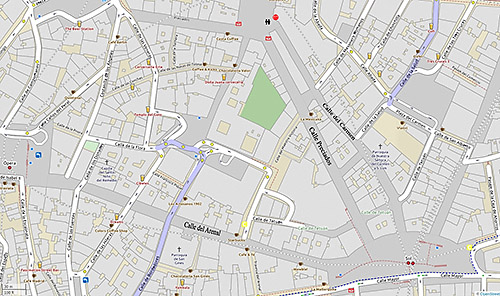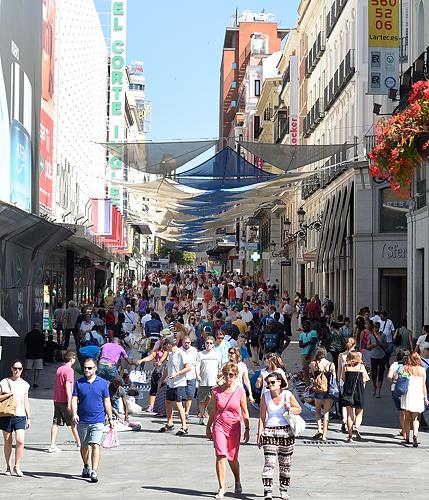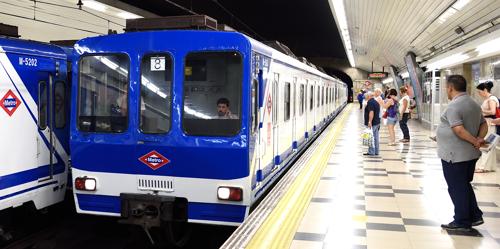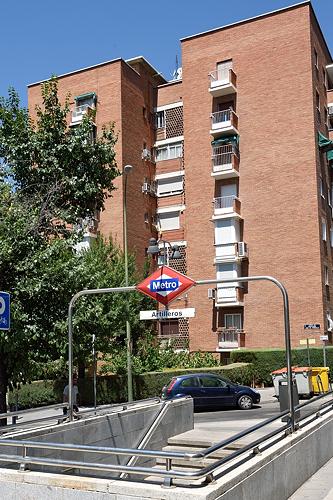Now that I’ve been here a month:
FANTASTIC PEDESTRIAN LIFE
The clip below shows some of the pedestrian streets branching off from Puerta del Sol. I’ve been too busy boning up on my irregular verbs to study recent Madrid history, but gather that callers-of-shots here are determined to put people and transit before cars in the city center.

Please follow this link to the Open Street Maps original and mouse around a bit. The streets in gray are either pedestrian-only or pedestrian-mostly. In the central city, I can walk nearly a mile from Retiro Park to Plaza Mayor without dealing with much auto traffic.
The summer sun doesn’t set here until 9:30 at night, and Madrileños seem far more fond than Americans of strolling their parks, plazas and walkways. The result: a central city renaissance for the heel-and-toe traveler.

(If reading in Southern California: picture a busy afternoon on the Third Street Promenade, and imagine the cheery vibe extending to dozens of fictive car-free streets throughout Santa Monica.)
MANY ATTRACTIVE RESIDENTS
A world-traveled chum once remarked that Southern Europeans seemed to have stood first in line when Odin handed out the handsome pills. He meant Italy. He should have included Spain.
That’s a generalization. Madrid includes old, young, plump, thin, short, tall, and plenty of viejito feos like your distinguished scribe, but the knock-out rate per capita is still plenty high, and I don’t want to commit the journalistic sin of staying mum about so conspicuous a trait because I don’t know how to describe it in a PC way.
I think you’d notice if you were here.
No, I’m not going to include an educational photo.
BACK TO L.A. AIR
Madrid has restricted auto traffic and embraced pedestrian-friendly streets largely to combat notorious air pollution. It’s ahead of L.A, but not by much. Expect plenty of cars. I’ve dealt with an occasional itchy throat since arrival, miss San Francisco breezes.
LIFE IN A REAL TRANSIT CITY
In 2014, a Madrid Metro rep proudly described her city’s metro to me as the best on terra firma. I wouldn’t be that generous, but it doesn’t trail far behind Europe’s best, and is thus light years ahead of what I was used to in California.

Compare this superimposed-on-the-street-grid map of the Madrid Metro to a similar map for BART of Northern California.
Zoom in to a mile, 2,000 feet, 1,000 feet. Snoop around a bit. BART offers close proximity between stations on Market Street, and nowhere else in San Francisco. In contrast, the Spanish strap hanger can count on a short walk between metro stops at points all over central Madrid.
A subway doth not a complete transit system make. I might form a less charitable view of transit here if dependent on an un-touristy, work-a-day bus line to shepherd me to or from a job. That said: a metro is usually a city’s transit backbone, and metro expansion costs in Madrid have been far, far lower than conquerable costs in the U.S.
Please look at that Google Maps overlay again. Zoom in close, check out the distance between stations; join me in feeling happily dazed by how easily I can get around my new home without a car.
In San Francisco, I braced myself for a long, dismal bus ride to admire the greenery at Lands’ End or Golden Gate Park. For food shopping, I used my car. In Madrid, I can ride the metro to Retiro Park or Casa de Campo, and shlep groceries home from whichever next-to-the-subway El Corte Inglés superstore strikes my fancy. (Although I’d expect to pay less and choose from a larger variety at the employee-owned WinCo Foods warehouse I patronized last, a mere 5,750 miles west in California.)

I visited European transit Valhallas in 2014 and 2015, but this is the first time I’ve actually lived in one. I’m still pinching myself.
City transit isn’t perfect: a Madrileña complained of malfunctioning escalators, just as U.S. strap hangers do, as well as transit strikes timed to coincide with the tourist season. She still expressed shock and amusement when I shared my photo of an unusually gruesome New York City subway station. No metro stop in Madrid is nearly as filthy.
ENGLISH SPEAKER AS POTENTIAL VIP
Madrid is not especially quick with an English phrase book. Regard this as a potential negative for the monolingual U.S. tourist, who may struggle to be understood at off-the-beaten-track stores and hotels.
For me, it’s mostly a plus. I arrived as an intermediate Spanish speaker, am delighted to do almost all of my yakking in the native tongue. Further: many Madrileños are eager to learn English, and will flock to the native speaker willing to participate in intercambios, either through Conversation Exchange or one of Madrid’s many language exchange meetups.
OLD CITY CENTER, NEW SUBURBS
‘Old’ is relative. Even central Madrid is a babe in the woods next to Athens or Rome. Some of the suburbs, however, are new even by U.S. norms. An intercambio partner recommended an apartment in the quiet, affordable Moratalaz district on the #9 metro line. Moratalaz sprang into life in the 1960s.

The photo shows the proximity of an apartment complex to Moratalaz’ Artilleros station. I will hand off once again to an online Google map, invite you to visit the same corner in Street View and scroll north on Vinateros.
See all the multi-story brick apartment buildings? Pure TOD … and, to a naysayer, I suppose: pure transit gulag.
I strolled this neck of Vinateros a few days ago. I harbor an unusually strong distaste for the draping of laundry on apartment porches, but otherwise found the nabe as potentially appealing as my intercambio pal suggested. Dull, perhaps. Uniform. Far less spacious than car-dependent American tract houses. But livable.
Idealista shows what can be rented here. A euro is about $1.10 USD. (Please discount the abominable quality of the photos; for reasons unknown, Spaniards post some of the most wretched ‘rental available’ shots I’ve ever seen. Antoni “we own the image” Gaudí may spin in his grave.)
(Caveat: I haven’t visited other TOD neighborhoods here, don’t know what I’d think of them.)
A WORRIED, OFTEN PESSIMISTIC SPAIN
I have not set up camp in an untroubled country.
Millenials met at intercambios cast doubt on the hardiness of economic recovery here. Jobs are in short supply, they say, pay poorly and ask a lot. Peers who long for the fixed-for-a-lifetime gigs of their parents’ generation are dreaming of a security that Spain no longer offers.
News reports describe Germany as the land of opportunity. A retiree with a secure income stream may move to Madrid, sign up for Spanish classes, cast pleased eyes on the tourist-centric street life seen at Puerta del Sol. Career-minded young Spaniards have to quit their own country, wrestle with unfamiliar grammar in Berlin Deutsch classes.
I’m quite fond of my new home, at least so far, but am not trying to make a living here. That matters.
* * * * *
More photos: https://www.flickr.com/photos/36217981@N02/albums/72157648793450795